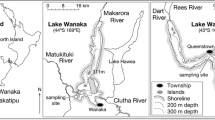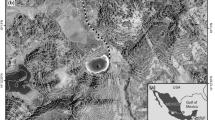Abstract
Regime shifts in shallow lakes are typically characterized by submerged macrophyte (clear water regime) or phytoplankton (turbid regime) dominance. Climate warming is expected to affect water quality and facilitate turbidity in lakes, but we may also expect synergistic effects on organisms’ interactions from climate and local specific dynamics in lakes. We here examined long-term changes in phytoplankton composition in July and August from 1980 to 2011 in a temperate shallow lake, Lake Krankesjön, a dataset including 21 years throughout a 31-year period. We hypothesize that although effects of the ongoing climate change are visible in our long-term data set, local specific dynamics override climate effects. We found that cyanophytes were the most abundant phytoplankton taxa among which small-sized colonial cyanobacteria were dominant. Both population density of small-sized colonial cyanobacteria and maximum water temperature increased over the period of study. However, the variations in the phytoplankton assembly were likely mainly related to three principal factors, including the local availability of nutrients, grazing from zooplankton, and possibly, an increasing trend in temperature. The first two factors are associated with the local specific dynamics, while the last with regional climate. Our long-term study showed that although there were potential climate warming effects on the phytoplankton community, local factors, such as biotic interactions and nutrient availability, were likely stronger drivers than climate warming in Lake Krankesjön at least over the last 30-year period.





Similar content being viewed by others
References
Auer I, Böhm R, Jurkovic A, Lipa W, Orlik A, Potzmann R, Schöner W, Ungersböck M, Matulla C, Briffa K (2007) HISTALP—historical instrumental climatological surface time series of the Greater Alpine Region. Int J Climatol 27:17–46
Bayley SE, Prather CM (2003) Do wetland lakes exhibit alternative stable states? Submersed aquatic vegetation and chlorophyll in western boreal shallow lakes. Limnol Oceanogr 48:2335–2345
Bayley SE, Creed IF, Sass GZ, Wong AS (2007) Frequent regime shifts in trophic states in shallow lakes on the Boreal Plain: alternative” unstable” states? Limnol Oceanogr 52:2002–2012
Blenckner T, Adrian R, Livingstone DM, Jennings E, Weyhenmeyer GA, George D, Jankowski T, Järvinen M, Aonghusa CN, Noges T (2007) Large-scale climatic signatures in lakes across Europe: a meta-analysis. Glob Change Biol 13:1314–1326
Blindow I (1992) Long-and short-term dynamics of submerged macrophytes in two shallow eutrophk lakes. Freshw Biol 28:15–27
Blindow I, Andersson G, Hargenby A, Johansson S (1993) Long-term pattern of alternative stable states in two shallow eutrophic lakes. Freshw Biol 30:159–167
Blindow I, Hargeby A, Wagner B, Andersson G (2000) How important is the crustacean plankton for the maintenance of water clarity in shallow lakes with abundant submerged vegetation? Freshw Biol 44:185–197
Bottrell HH, Duncan A, Gliwicz ZM, Grygierek E, Herzig A, Hillbricht-Ilkowska A, Kurasawa H, Larsson P, Wieglenska T (1976) A review of some problems in zooplankton production studies. Nor J Zool 24:419–456
Brönmark C, Brodersen J, Chapman BB, Nicolle A, Nilsson PA, Skov C, Hansson LA (2010) Regime shifts in shallow lakes: the importance of seasonal fish migration. Hydrobiologia 646:91–100
Carpenter SR, Kinne O, Wieser W (2003) Regime shifts in lake ecosystems: pattern and variation. International Ecology Institute Oldendorf/Luhe, Germany
Daufresne M, Lengfellner K, Sommer U (2009) Global warming benefits the small in aquatic ecosystems. Proc Natl Acad Sci 106:12788–12793
Genkai-Kato M, Vadeboncoeur Y, Liboriussen L, Jeppesen E (2012) Benthic-planktonic coupling, regime shifts, and whole-lake primary production in shallow lakes. Ecology 93:619–631
Gerten D, Adrian R (2002) Effects of climate warming, North Atlantic oscillation, and El Niño-Southern oscillation on thermal conditions and plankton dynamics in Northern Hemispheric lakes. Sci World J 2:586–606
Gille ST (2002) Warming of the Southern Ocean since the 1950s. Science 295:1275–1277
Hansson LA, Nicolle A, Brodersen J, Romare P, Brönmark C, Skov C (2007) Consequences of fish predation, migration, and juvenile ontogeny on zooplankton spring dynamics. Limnol Oceanogr 52:696–706
Hansson LA, Nicolle A, Brönmark C, Hargeby A, Lindström Å, Andersson G (2010) Waterfowl, macrophytes, and the clear water state of shallow lakes. Hydrobiologia 646:101–109
Hansson L-A, Nicolle A, Granéli W, Hallgren P, Kritzberg E, Persson A, Björk J, Nilsson PA, Brönmark C (2013) Food-chain length alters community responses to global change in aquatic systems. Nat Clim Change 3:228–233
Hargeby A, Andersson G, Blindow I, Johansson S (1994) Trophic web structure in a shallow eutrophic lake during a dominance shift from phytoplankton to submerged macrophytes. Hydrobiologia 279:83–90
Hargeby A, Blindow I, Hansson LA (2004) Shifts between clear and turbid states in a shallow lake: multi-causal stress from climate, nutrients and biotic interactions. Arch für Hydrobiol 161:433–454
Hargeby A, Blindow I, Andersson G (2007) Long-term patterns of shifts between clear and turbid states in Lake Krankesjön and Lake Tåkern. Ecosystems 10:29–36
Hyenstrand P, Blomqvist P, Pettersson A (1998) Factors determining cyanobacterial success in aquatic systems-a literature review. Arch für Hydrobiol Spec Issues Adv Limnol 51:41–62
IPCC (2013) Fifth assessment report of the intergovernmental panel on climate change. Cambridge University Press, Cambridge
Jeppesen E (1998) The ecology of shallow lakes: trophic interactions in the pelagial. National Environmental Research Institute, Silkeborg
Kosten S, Huszar VLM, Bécares E, Costa LS, Donk E, Hansson LA, Jeppesen E, Kruk C, Lacerot G, Mazzeo N, De Meester L, Moss B, Lürling M, Nõges T, Romo S, Scheffer M (2012) Warmer climates boost cyanobacterial dominance in shallow lakes. Glob Change Biol 18:118–126
Levitus S, Antonov JI, Boyer TP, Stephens C (2000) Warming of the world ocean. Science 287:2225–2229
Lindeman RH, Merenda PF, Gold RZ (1980) Introduction to bivariate and multivariate analysis. Scott Foresman, Glenview
Markensten H, Moore K, Persson I (2010) Simulated lake phytoplankton composition shifts toward cyanobacteria dominance in a future warmer climate. Ecol Appl 20:752–767
Moberg A, Alexandersson H, Bergström H, Jones PD (2003) Were southern Swedish summer temperatures before 1860 as warm as measured? Int J Climatol 23:1495–1521
Moss B, Madgwick J, Phillips G, Authority B (1996) A guide to the restoration of nutrient-enriched shallow lakes. Broads Authority Norwich, Norfolk
Nicolle A, Hansson L-A, Brodersen J, Nilsson PA, Brönmark C (2011) Interactions between bottom-up and top-down forces shape zooplankton population dynamics. Plos One 6:e16534
Paerl HW, Fulton RS (2006) Ecology of harmful cyanobacteria. In: Graneli E, Turner J (eds) Ecology of harmful algae. Springer, Berlin, pp 95–109
Paxinos R, Mitchell JG (2000) A rapid Utermöhl method for estimating algal numbers. J Plankton Res 22:2255–2262
R Development Core Team (2014) R: A language and environment for statistical computing. R Foundation for Statistical Computing, Vienna, Austria. http://www.R-project.org/
Robarts RD, Zohary T (1987) Temperature effects on photosynthetic capacity, respiration, and growth rates of bloom-forming cyanobacteria. NZ J Mar Freshwat Res 21:391–399
Scheffer M (2004) Ecology of shallow lakes. Kluwer Academic Publishers, Dordrecht
Scheffer M, Jeppesen E (2007) Regime shifts in shallow lakes. Ecosystems 10:1–3
Scheffer M, van Nes EH (2007) Shallow lakes theory revisited: various alternative regimes driven by climate, nutrients, depth and lake size. Hydrobiologia 584:455–466
Scheffer M, Carpenter S, Foley JA, Folke C, Walker B (2001) Catastrophic shifts in ecosystems. Nature 413:591–596
Schindler DW, Smol JP (2006) Cumulative effects of climate warming and other human activities on freshwaters of Arctic and subarctic North America. AMBIO 35:160–168
Straile D, Jöhnk K, Rossknecht H (2003) Complex effects of winter warming on the physicochemical characteristics of a deep lake. Limnol Oceanogr 48:1432–1438
Suttle KB, Thomsen MA, Power ME (2007) Species interactions reverse grassland responses to changing climate. Science 315:640–642
van Donk E, van de Bund WJ (2002) Impact of submerged macrophytes including charophytes on phyto-and zooplankton communities: allelopathy versus other mechanisms. Aquat Bot 72:261–274
Vasama A, Kankaala P (1990) Carbon-length regressions of planktonic crustaceans in Lake Ala-Kitka (NE-Finland). Aqua Fennica 20:95–102
Vörös L, Mózes A, Somogyi B (2009) A five-year study of autotrophic winter picoplankton in Lake Balaton, Hungary. Aquat Ecol 43:727–734
Xu J, Wen Z, Gong Z, Zhang M, Xie P, Hansson L-A (2012) Seasonal trophic niche shift and cascading effect of a generalist predator fish. Plos One. doi:10.1371/journal.pone.0049691
Xu J, Wen Z, Ke Z, Zhang M, Zhang M, Guo N, Hansson L-A, Xie P (2014) Contrasting energy pathways at the community-level as a consequence from regime shifts. Oecologia. doi:10.1007/s00442-013-2878-2
Acknowledgments
We are grateful to all staff from Aquatic Ecology unit at Lund University for collecting the samples during the long-term monitoring programme. We thank Susanne Gustafsson for her help on the phytoplankton identification. The study was financed by the Swedish Research Council FORMAS, the Swedish Research Council (VR), the National Natural Science Foundation of China (Grant No. 31200359 to MZ and Grant Nos. 31170439 and 31370473 to JX), and Special Fund for Agro-scientific Research in the Public Interest Project (201203083).
Author information
Authors and Affiliations
Corresponding author
Additional information
Handling Editor: Bas W. Ibelings.
Rights and permissions
About this article
Cite this article
Zhang, M., Xu, J. & Hansson, LA. Local environment overrides regional climate influence on regime shift in a north temperate lake. Aquat Ecol 49, 105–113 (2015). https://doi.org/10.1007/s10452-015-9509-4
Received:
Accepted:
Published:
Issue Date:
DOI: https://doi.org/10.1007/s10452-015-9509-4




